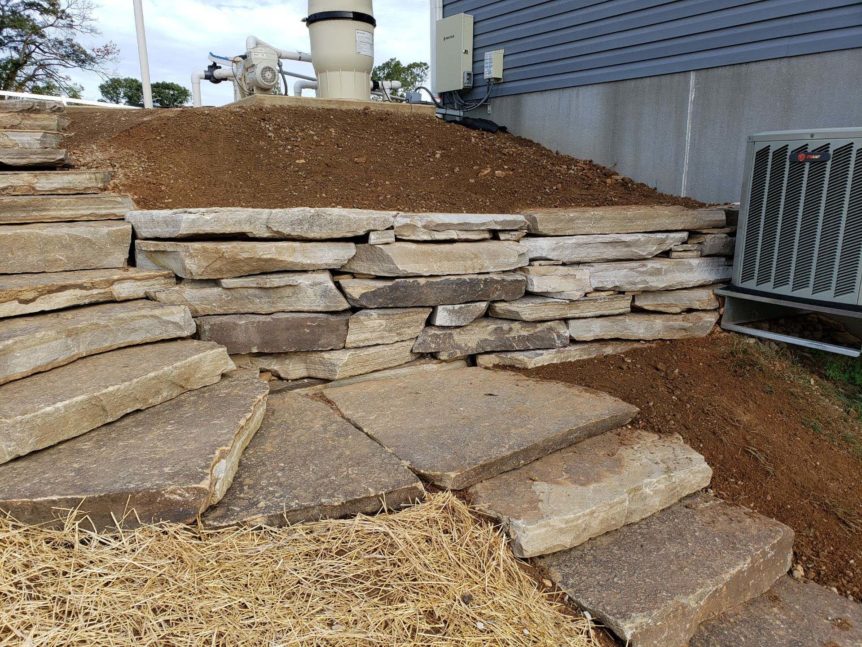When Should Retaining Walls be Used?
Retaining walls on a residential property can serve multiple purposes. When designed properly, they are both functional and aesthetic, adding an attractive vertical dimension to a yard.
Erosion Prevention. Do you have a slope in the yard that tends to lose topsoil when it rains? Retaining walls can help stabilize the slopes and prevent loss of topsoil, grasses and plants.
Slope Stability. Steep slopes can be prone to sink holes and slides. In areas where a steep slope is adjacent to your home, driveway or parking area, a retaining wall is a good choice to stabilize the slope while redistributing and reducing reduce lateral pressures.
Site Drainage. Occasionally the natural curvatures in a yard can result in concentrated runoff rushing down a hill or slope. A retaining wall can be designed to slow down and redirect runoff so it flows in a controlled fashion.
Terracing. Terracing is the idea of building steps into a slope to make it useful for decoration and plantings. Terracing prevents erosion and makes a slope easier to mow and maintain.
Increased Useable Area. Sometimes it’s helpful to have additional area in your yard for parking, patio or walkways. Retaining walls allow you to excavate into the existing grade to create usable flat space while preserving the adjacent area and grade as-is.
Best Retaining Wall Options for Materials in Maryland
There are many choices when it comes to materials to use for your wall. The most common are pavers, stacked stone, bricks, or cinder blocks. Most of the options available are just as effective as any other if you are planning to install your walls in Maryland. The wall material you choose mainly depends on your preference and what pleases your eye. It’s also important to have an idea of the function you’d like your wall to serve as.
For example, when it comes down to garden spaces, retaining walls that don’t hold back large sections of a hill are often made to be more decorative than those with stacked stone or pavers. Overall, cinder blocks or bricks are better for hillsides, which can be covered with a more decorative facade.
Installing Retaining Walls
Installing a retaining wall is generally labor intensive and requires equipment. If you are using it to hold back a hillside, it is highly recommended that you hire a contractor to build the wall. Important calculations are made to measure the load of the embankment that guides the design and installation processes.
One of the potential dangers of doing it yourself is the hill collapsing before the wall is placed. Not only are there safety risks from a slope failure, but if not done professionally, the wall could give in to wear and tear and become a future hazard.
However, for simple garden walls that you would like to make yourself, you could follow directions through online tutorial videos for the type of wall you want to build. Walls made from pavers are amongst the easiest types to build and require only a few materials. However, to ensure you get the job done right the first time, a professional landscaper is recommended.
Maintenance of Retaining Walls
Once installed, retaining walls need to be inspected and maintained. We recommended conducting a visual inspection at least once a year of the wall. Look for loose stones, bricks or pavers,, roots that are growing between stones, any signs of movement, and water that may be seeping from the wall. These could be signs of week spots that may need reinforcement or additional attention.
A good ground cover will help re-absorb water along the retaining wall. However, be on the look-out for weeds, which can penetrate and open crevices in the wall.
To reduce weeds or tree suckers from regrowing after you remove them when you build the retaining wall, you can lay down permeable landscape fabric that will drain water. This will prevent weeds and suckers from emerging. The fabric comes in different thicknesses and can be tailored to meet your needs.
Retaining walls can be beautiful additions to your landscape. They add dimension and levels to your garden and can increase the square footage of available planting and living space. Also, the addition of retaining walls can add space to your garden that can prevent damage from landslides.
While hiring a contractor is recommended, it is possible to do some small-scale projects yourself with the proper tools. Be sure to do your research before starting a project and figure out what it takes to get to the end result.
Chesapeake Landscapes provides retaining wall installation in Maryland, including Harford County, Baltimore County, and Cecil County. Contact us today to schedule your onsite consultation!

